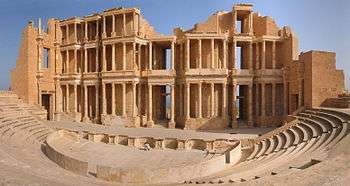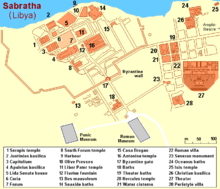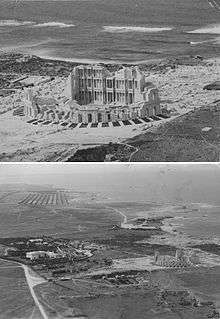Sabratha
| Sabratha صبراتة | |
|---|---|
 Sabratha Location in Libya | |
| Coordinates: 32°47′32″N 12°29′3″E / 32.79222°N 12.48417°E | |
| Country |
|
| Region | Tripolitania |
| District | Zawiya |
| Elevation[1] | 30 ft (10 m) |
| Population (2004)[1] | |
| • Total | 102,038 |
| Time zone | EET (UTC+2) |
| Archaeological Site of Sabratha | |
|---|---|
| Name as inscribed on the World Heritage List | |
 | |
| Type | Cultural |
| Criteria | iii |
| Reference | 184 |
| UNESCO region | Arab States |
| Inscription history | |
| Inscription | 1982 (6th Session) |

Sabratha, Sabratah or Siburata (Arabic: صبراتة), in the Zawiya District[2] of Libya, was the westernmost of the ancient "three cities" of Roman Tripolis. From 2001 to 2007 it was the capital of the former Sabratha wa Sorman District. It lies on the Mediterranean coast about 66 km (41 mi) west of modern Tripoli. The extant archaeological site was inscribed as a UNESCO World Heritage Site in 1982.
Ancient Sabratha
Sabratha's port was established, perhaps about 500 BC, as a Phoenician trading-post that served as a coastal outlet for the products of the African hinterland. The Phoenicians gave it the Lybico-Berber name 'Sbrt'n',[3] which suggests that there may have been a native settlement built there prior to the Phoenicians' arrival. Sabratha became part of the short-lived Numidian Kingdom of Massinissa before being Romanized and rebuilt in the 2nd and 3rd centuries AD. The Emperor Septimius Severus was born nearby in Leptis Magna, and Sabratha reached its monumental peak during the rule of the Severans. The city was badly damaged by earthquakes during the 4th century, particularly the quake of AD 365. It was rebuilt on a more modest scale by Byzantine governors. The town was site of a bishopric.[4] Within a hundred years of the Arab conquest of the Maghreb, trade had shifted to other ports and Sabratha dwindled to a village.
Ancient ruins in danger of erosion damage [ April 2016 report ]
Due to soft soil composition and the nature of the Coast of Sabratha being mostly made up of soft rock and sand, the Ruins of Sabratha are undergoing dangerous periods of coastal erosion. The public baths, Olive Press building and 'Harbor' can be observed as being most damaged as the buildings have crumbled due to storms and unsettled seas.
This Erosion of the coast of Ancient Sabratha can be seen yearly with significant differences in beach layout and recent crumbled buildings. Breakwaters set in the vicinity of the Harbor and Olive press are inadequate and too small to efficiently protect the Ancient City of Sabratha.
The archaeological site

Besides its Theatre at Sabratha that retains its three-storey architectural backdrop, Sabratha has temples dedicated to Liber Pater, Serapis and Isis. There is a Christian basilica of the time of Justinian and also remnants of some of the mosaic floors that enriched elite dwellings of Roman North Africa (for example, at the Villa Sileen, near Khoms). However, these are most clearly preserved in the coloured patterns of the seaward (or Forum) baths, directly overlooking the shore, and in the black and white floors of the Theatre baths.
There is an adjacent museum containing some treasures from Sabratha, but others can be seen in the national museum in Tripoli.
In 1943, during the Second World War, archaeologist Max Mallowan, husband of novelist Agatha Christie, was based at Sabratha as an assistant to the Senior Civil Affairs Officer of the Western Province of Tripolitania. His main task was to oversee the allocation of grain rations, but it was, in the words of Christie's biographer, a "glorious attachment", during which Mallowan lived in an Italian villa with a patio overlooking the sea and dined on fresh tunny fish and olives.[5]
Modern Sabratha
Wefaq Sabratha is the football club, playing at Sabratha Stadium.
In 2011, the town became involved in the Libyan Civil War. At first seeming to have rebelled against the government, with sword-wielding townspeople fighting against soldiers with guns,[6] as of 2 March it had been retaken by pro-Gaddafi forces.[7][8] However, the town was recaptured by the rebels in August.[9]
[10] Report: In Jan 2014, The bodies of two foreign nationals were discovered on Tallil Seyahi Beach on the outskirts of the coastal city of Sabratha, according to the Sabratha Media Center. An initial police investigation shows the two were having a picnic in a somewhat remote area near a partially built resort. A photo posted on the Sabratha Media Center Facebook page purports to show the man and woman, who are lying face down in the sand. Near the bodies is a blanket that is spread out, with food and drinks strewn about. A backpack sat nearby. The identities and the nationalities of the two, described only as a man and a woman, have not been released.
Panorama

References
- 1 2 Wolfram Alpha
- ↑ شعبيات الجماهيرية العظمى – Sha'biyat of Great Jamahiriya, accessed 20 July 2009, in Arabic
- ↑ Septimus Severus page 2
- ↑ Francois Decret, Early Christianity in North Africa(James Clarke & Co, 2011) p83
- ↑ Janet Morgan (1984) Agatha Christie: a Biography
- ↑ The Great Swordfight of Sabratha: How Libyan freedom fighters clashed with Gaddafi's army with 2ft scimitars
- ↑ Amid pro-regime chants, some tell a different tale in contested Libyan town
- ↑ Report: Libya deploys troops in Sabratah after protests
- ↑ http://www.telegraph.co.uk/news/worldnews/8703665/Egypt-Libya-and-Syria-live.html
- ↑ http://edition.cnn.com/2014/01/02/world/africa/libya-foreigners-killed/
Further reading
- Matthews, Kenneth D. (1957) Cities in the Sand, Leptis Magna and Sabratha in Roman Africa University of Pennsylvania Press, Philadelphia, OCLC 414295
- Ward, Philip (1970) Sabratha: A Guide for Visitors Oleander Press, Cambridge, UK, ISBN 0-902675-05-2
External links
| Wikimedia Commons has media related to Sabratha. |
- UNESCO archaeological site of Sabratha
- Complete photo coverage of the archeological site
- Sabratha, image from the BSR Library and Archive digital collections. Ward-Perkins photographic collection
- LookLex article
Coordinates: 32°47′32″N 12°29′3″E / 32.79222°N 12.48417°E